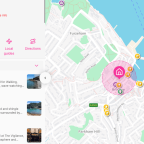
What is the carbon impact of a website?
How we can make a difference to reduce our impact on the environment is a topic that is at the forefront of people’s minds – and quite rightly so. We are at a turning point in terms of the health of our planet and it is refreshing to see so many people so keen to make a difference in any way they can.
Recycling, reducing our usage of single-use plastics and minimising our fuel consumption are some of the more obvious ways people are able to make that difference, but there are some aspects of our daily lives that have a huge impact, but aren’t quite so obvious . . .
The internet for example. The energy required to power an email or load a webpage is a pretty minimal amount. But when we multiply this by the number of people who are using the internet, around 4.1 billion people, the picture suddenly becomes a little different.
3.7% of global greenhouse gas emmisions is accounted for by internet consumption
3.7% is actually quite a huge number. To put this into perspective, commercial aviation accounts for around 2.4% of emissions globally.
It may seem like a huge amount, but when we consider the amount of energy used to power the supercomputers (hundreds of millions of them) that hold the website data, or email data for all of the websites in the world, this adds up!
So what can we do to combat this and reduce our online emissions?
The internet is here to stay. It has become integral to our lives in more ways than one, both commercially and domestically – so what can be done to limit our impact here?
1. Streamline Web Pages
Every piece of information on your webpage is data that needs to be transferred to a user’s browser, be that on desktop, tablet or mobile.
By minimising the amount of data that needs to be stored on the server and transferred on each page load, we can reduce the level of emissions created from each of our web pages.
Videos and images are the worst culprits in terms of data, so where these are necessary, it is important to make sure they are stored and served in the most optimised format possible.
With images, we can make sure that we load images that are the right size for the space on the site. We can also implement what is known as ‘lazy loading’, so that the content only loads as it shows up on the screen.
With videos, we can make sure these don’t load unless the user decides to play them so that this content is not loaded until actually required.
Taking a few steps like this and cleaning up your pages every now and then is essential for reducing your carbon footprint.
Not only will this reduce the impact your website has each time it is loaded by one of your visitors, but it will also have a positive impact on your site speed and with that your search engine optimisation ranking!
2. Eco-friendly Hosting Servers
Every website and all of its data is stored on one of those supercomputers I mentioned earlier. These are known as hosting servers.
These are probably one of the biggest contributors to the carbon emissions of the internet as a whole, both in terms of hardware manufacturing and in terms of running and cooling these machines.
A number of hosting providers have moved across to using renewable energy to provide sustainable services, but there are many who still need to make that transition.
Make sure that your hosting service provider runs its services on renewable energy. At PB+J Web Design, we are proud to say that the hosting services we provide are all run off 100% renewable energy!
3. Delete Unnecessary Emails
I am sure we have all been guilty of this – subscribing to mailing list after mailing list to take advantage of free content, only to end up with email accounts that just fill up with junk that we never read.
Don’t get me wrong, there are some email subscriptions that can be hugely informative, but others just sit there, clogging up storage space.
Just remember, like websites, emails are not just floating around somewhere in the ether, but are all stored on another one of those supercomputers. The more emails we keep, the more storage is needed and the more supercomputers will be needed to handle that capacity.
4. Offset Anything You Can't Affect
Whilst we can all do our best to mitigate the effects of the internet and our websites on the environment, there is only so much that we can possibly do, without shutting the whole system down – which isn’t going to happen!
So with that in mind what else can we do to negate the impact we are having?
There are all sorts of projects and initiatives that we can sign up to, that will offset our carbon emissions in other ways. Whether that is planting trees or supporting projects that help implement renewable energy, there hundreds of ways we can help.
With this in mind, PB+J Web Design has decided to offset all of their web design projects both moving forwards and historically, by supporting such projects, with a view to becoming as carbon neutral as possible. We will keep you posted with some of the different projects we will be supporting, so be sure to follow us on social media for updates!
Let's bring down the environmental cost of the internet together!
It may seem as though this problem is so much bigger than us as individuals, but the more each of us does ourselves, the more we will be able to affect as a collective.
Let us know what you will be doing to improve your impact on the internet emissions in the comments below, or if you would like some support to imrove the impact of your website, get in touch today!







